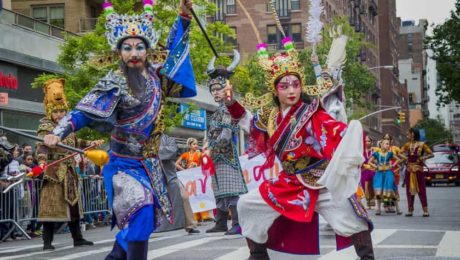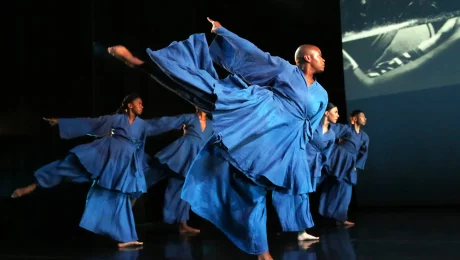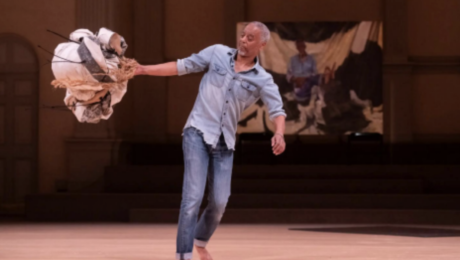Dance Parade’s Performance “Book Club” without the books!

Dancing Matters, Dance Parade’s “Book Club for Dance” will bring people together in a diverse meetup group centering dance performances and experiences in an open and honest discussion shared in public and online. Inspired by and partially modelled on the Peformance Club founded and run for several years by writer Claudia LaRocco, Dancing Matters invites amateurs, dance professionals and enthusiasts alike to join in the adventure of seeking out dancing worthy of critical consideration and support in the metro New York City area.
Join the next Dancing Matters outing as we head to Lincoln Center on 9/11 to see former Dance Parade Grand Marshal Jacqulyn Buglisi’s Table of Silence Project. Over 100 dancers, opera singers and musicians choreographed in a way that reflects a prayer for peace. Get FREE TICKETS for the Monday 9/11 8am performance here and join the discussion afterwards!
- Published in 2023, Genre Buzz
Ronald K. Brown’s EVIDENCE at the Joyce!
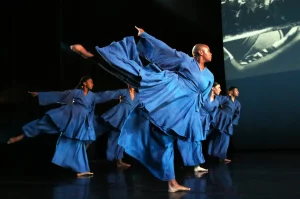
We had all witnessed EVIDENCE
Sixteen of us then made it across the street to the Chinese restaurant on the eve of the year of the water rabbit, 4720, in China, 14 time zones ahead of us. According to the official Chinese state news agency Xinhua, tradition notes the rabbit as the luckiest of the 12 zodiac animals, representing peace and longevity. Kimmy Yam claims it also as evocative of the power of empathy. In Vietnam, the same day marks the eve of the year of the cat, a totem characterized as tranquil, realistic, intelligent, and artistic. All seven of these qualities had just been on display across 8th Avenue on the stage of the Joyce Theater, clearly visible through the front windows of the eatery that had stayed open late just for us.
We got to work helping Nina, our hostess, rearrange tables into a large irregular square in order to accommodate everyone in the group at a single platform within easy enough speaking distance from one another. This marked the first collaborative action that a Dancing Matters crew undertook as a community. As an omen of renewal and resilience that seemed to echo what we had just taken in, a concert consisting of three works by Ronald K. Brown crowned with an onstage appearance by the creator alongside Associate Artistic Director Arcell Cabuag at the final curtain bow, the physical nature of our initial communal activity augured well no matter which calendar you may consult.
Dancing Matters aims to create, foster, and promote democratic and collaborative critical response from across the wide and inclusive spectrum of dance related communities that the Dance Parade and DanceFest manifests each May. The group at the square table included several current and former professional dancers and choreographers, practitioners of the 5Rhythms meditative movement practice founded by the late Gabrielle Roth, at least one professional DJ, one creative writer with a movement background and others whose relationship to dancing might be characterized more ineffably. We went around the table person by person, each offering a few words that they might share with one another or a loved one as a way of conjuring and encapsulating an overall reaction to what they had just experienced.
Our professional DJ proved the first to comment on the formidable contributions of Brown’s collaborators in music and costuming. The curtain had parted on “Open Door” to begin the show revealing Andrew Antron seated at the baby grand piano audience left with the rest of Arturo O’Farrill’s band Resist made up of seven other members of the Afro Latin Jazz Orchestra in a line across the rear of the stage back lit at the cyclorama and largely in silhouette. The choreography, originally commissioned and performed by the Alvin Ailey American Dance Theatre in 2015, received its company premiere with these performances at the Joyce and the live presence of this fine ensemble along with their crisp Afro Cuban polyrhythmic sound served as a foretaste of the exquisite production values that would apply across the evening.
Our DJ did not neglect the music of Jason Moran accompanying the middle offering “The Equality of Night and Day,” which received its New York City premiere with these Joyce presentations. Nor did she ignore the Duke Ellington, Roy Davis, Jr., and Fela Anikulapo Kuti suite for the perennial favorite and crowd-pleasing finale “Grace,” commissioned, like “Open Door,” for the Ailey troupe (1999) and re-configured for EVIDENCE in 2003. Each recorded score sparked a similarly strong dialogue with the dancing and other stage elements.
Arcell Cabuag receives acknowledgement as Associate Choreographer for “Open Door.” Keiko Voltaire designed the costumes for this opus matching the imaginative flow if not the striking color of Omotayo Wunmi Olaiya’s designs for the other two works. Except for the projected photo collages curated by Deb Willis for “The Equality…”, no one at the table mentioned the superb set and lighting design and technical direction from Tsubasa Kamei that sustained throughout the evening, nor the accompanying text heard in recordings of the political activist and academic Angela Y. Davis. My oversight, I fear.
I have known and admired Ron Brown and his work, sometimes close at hand, since he, Dean Moss and I each presented duets as choreographer/performers decades ago on a single program of the Fresh Tracks platform at Dance Theater Workshop (DTW), which has since morphed into New York Live Arts. Yet this concert offered my first opportunity to ingest at one sitting such a panoply of his enormous creative output across the years of a generation and consider the significance of his contribution to the field not only in terms of his work over time but of his mentorship and development of a legion of strong voices among the dancers who have risen in his company such as Camille A. Brown, to point out just one.
It seemed to me that the mastermind of this home season within the warm and friendly confines of the Joyce engaged an interrogation in each of these three pieces, not only regarding individuality, community, and social justice as manifest in the movement of his company and the contributions of his collaborators, but among the technical discipline, tempos, rhythm and compositional elements that make dancing speak, especially as it draws from within bodies coming from across the African diaspora and beyond.
Besides the work of both Alvin Ailey and Camille A. Brown, between whom he represents a creative bridge, the choreography also recalled for me that of Garth Fagan in both its compositional invention and arresting deployment of stillness. I will leave it to other members of Dancing Matters to supplement as they wish.
Dancers in the Ronald K. Brown/Evidence company in “The Equality of Night and Day” at the Joyce Theater in New York.Credit…Andrea Mohin/The New York Times
Review: A Dance Searching for Harmony in an Unequal World
By Gia Kurlas
Jan. 18, 2023
“The Equality of Night and Day,” a New York premiere by the choreographer Ronald K. Brown and his company, Evidence, essentially starts out mid thought. A voice says, “And finally.”
It’s so no-nonsense that it practically sounds like a complete sentence. Spoken by the activist Angela Davis in a tone verging on weariness, the “and finally” urges the crowd — at least the one you imagine standing before her — to think about the larger picture, as she talks about issues that ail the United States, like “the assault against affirmative action” and “the increasing conservatism.”
The dancer Joyce Edwards, a silky powerhouse full of drama whether seemingly motionless or rippling her body with fervor, is poised center stage: She bends forward and rises back up with crossed wrists until her arms lift and bloom out like glorious wings. The lighting evokes the faded radiance of a sunset. As the other dancers gather around her, she clasps her hands, and we hear Davis ask that the people before her “think very deeply about what you can do to make a difference.”
Davis’s speeches are heard throughout this 2022 work, performed at the Joyce Theater, but better is its sparkling score by the jazz pianist Jason Moran. The music starts out spare and contained, but gradually builds with blistering, tinkering speed to get at, sonically, the urgency of not just one, but multiple generations that have faced oppression.
- Published in 2023, Dancing Matters
Engaging the Audience: Kinetic Light and Dean Moss model approaches
how do you welcome your audience?
“The actors never said hello to the audience,” theater director Anne Bogart quoted colleague Leon Ingulsrud as having complained in assessing a recent theater experience in the “Exit Interview” she gave the New York Times that appeared in November. “I thought that was really interesting” she continued. “The acknowledgment of that relationship, or how an audience interfaces, is the prize, I think.”
Two productions a week apart, each chosen as prospective outings for Dancing Matters (DM), illustrated ways in which some dance and movement artists have been developing their own approaches to the public they have been welcoming back as dancing continues to crawl out of the live performance drought that descended under the blanket of the pandemic.
To be sure, restrictions and preventative measures remain in force: both the Clark Studio Theater at Lincoln Center, in presenting Kinetic Light’s Under Momentum, and Danspace Project at St. Marks Church in presenting Dean Moss’ Your marks and surface, each required masking among all patrons and non-performing staff throughout one’s presence in the theater and lobby. If this represents a “new normal” of indefinite duration that somewhat mutes interaction, could what these artists have developed in engaging their audiences push back in intriguing and hopeful directions?
Under Momentum with Kinetic Light
Clark Studio Theater, 7th Floor of the Rose Building, Lincoln Center, February 24
My introduction to the world as designed by Kinetic Light (KL) took place in August during the NYC premiere run of Wired at The Shed when I happened to attend the only performance delayed for 45 minutes by technical difficulties. You’ll be flying wheelchairs and you’ve encountered technical difficulties?
Members of the audience had grown restive during the wait in the lobby but the verbal welcome curtain speech by a member of the KL team accompanied by two American Sign Language (ASL) interpreters proved disarming in both its warmth, beginning with a brief but genuine apology for the delay, and its breadth. It might as well serve as a model for the prize that Ingulsrud and Bogart seek.
The equivalent introduction at the Clark Studio Theater for Under Momentum may not have included an access enumeration of the seven (7!) channels of Audimance (app) audio description that KL and The Shed had made available for Wired, but the (large print) program, available for the asking, listed it along with other accommodations. Nor did the pair of onstage curtain speech hosts alongside their ASL counterpart, Daniel Israilov from SignNexus, face a testy crowd. Having walked through the sun drenched 7th floor lobby of the Clark, where another pair of friendly greeters checked you in, reinforced the masking protocols, and offered to answer any questions, one arrived in the Studio Theater to an audience ambience of relaxed comfort and friendly banter that represented a waking dream of thoughtful inclusiveness.
The two sold-out Kinetic Light shows that I have attended have both featured live captioning, tactile exhibits, sensory “stim” materials, expanded accessible seating and a quiet or safe “Chill Out” space with facilitated exit and re-entry available to audience members at any time throughout the performance. More in evidence for Under Momentum than at Wired: haptic soundtrack interpretation and the continuous presence of Israilov who became in effect a third performer opposite Alice Sheppard and Laurel Lawson, the featured duo and co-choreographers whose passages on top of, over, across and around the inventively protean deployments and configurations of Sara Hendren’s modular ramp designs underpins the impetus for the work. Israilov’s physicalization of the musical score at the audience left corner just offstage of the playing area closest to us added its own level of interest to the remarkable musical score.
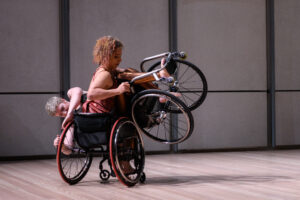
Laurel Lawson lays across Alice Sheppard’s lap as she pushes Alice’s left wheel rim with both hands. They wear shimmery costumes in autumnal tones as they spin in their wheelchairs. Photo by Filip Wolak / Whitney Museum of American Art.
Under Momentum struck me as the most concentrated and focused introduction to the work of the dancer/choreographers and the KL Ensemble that I might imagine. I rued the fact that the Dancing Matters group proved too early in its evolution to organize quickly enough to snag tickets before the show sold out. The piece provided a clinic in contemporary dance creation and performance at the highest level. Standing in the exit aisle at the right side of the audience, having been encouraged like everyone else to stand, sit or move around by the introductory hosts, I found myself able to maneuver consistently in such a way as to intently study every move and transition on the stage while keeping Israilov’s dance-like ASL interpretation of the musical score easily in view.
This simple accommodation freed the experience from a one-way presentation vibe and enabled a more interactive approach sans the stifling and in many cases unnecessary and even counterproductive regimens of most Western theatrical events. Its liberating and humanizing effect allowed a girlchild of perhaps five to seven years old to lie on the floor in a gap among the wheel and power chairs in a taped off area at the very front of the audience surrounded by coloring books that she never made use of in my observation, so fascinating did she find the goings on in front of her that, chin propped on her hands over bent elbows, she could almost have reached out to touch.
Lawson and Sheppard began the piece without their wheelchairs in a slowly unfolding and developing adagio duet atop one or two of the longest ramp elements turned on their side. They followed this section with a suite of other sections mostly involving dancing in and out of wheelchairs punctuated intermittently with blue tinted half-light reconfigurations of the set by a crew of stagehands.
The subtly shifting and affective lighting design by ensemble member Michael Maag came to the fore in these transitions, supporting mostly in silence/ambient sound an air of unfolding mystery that served as counterpoint to the excellent recorded score drawn from multiple composers and supplemented with a haptic experience design by Lawson and realized with the help of David Bobier and Jim Ruxton ofVibraFusion labs.
Over the course of the work’s 80-minute duration with intermission, I felt an increasing excitement as if Lawson and Sheppard had enabled me to re-live and reinterpret my own earliest, though later in life than most dancers, training in modern dance technique and composition. Here I found myself re experiencing side falls and lateral stretches, theme and variations and even balletic set pieces that I have been witnessing ever since I got into performative dancing and dance making.
Sequential solos for Sheppard and then Lawson featured some of the most amazing innovations and reimaginings I’ve seen performed in wheelchairs; extraordinary feats of invention and physical power. At one point in her solo Sheppard executes a series of side rolls on the floor in her wheelchair tracing a circle around the center of the stage: a terrestrial reinvention of the ring of airborne barrel turns so commonly performed in the male principal dancer and soloist variations of ballet.
Laurel Lawson lays across Alice Sheppard’s lap as she pushes Alice’s left wheel rim with both hands. They wear shimmery costumes in autumnal tones as they spin in their wheelchairs. Photo by Filip Wolak / Whitney Museum of American Art.
Every traditional dance iteration transforms itself in the bodies and minds of these two and their collaborators. This complements inventions and passages, such as what I will call the Sisyphean mirror duet, made possible only by utilizing the chairs and ramps.
Compositionally, the works’ structural rhythm, variation and even the pauses for set redeployment along with the sound score all add to more than the sum of the parts. The subtle and supple development of the onstage relationship between Lawson and Sheppard as both individuals and partners created an understated layer of dramatic intrigue. Oh, how I wish the Dancing Matters group could have experienced and discussed all this with me.
Dean Moss’ Your marks and surface
Dancespace Project, St. Marks Church in the Bowery, February 24, 2023
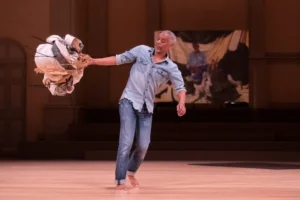
Dean Moss, a black man wearing blue jeans and a lighter blue chambray shirt, leans to his left to counterbalance a bundle of white cotton sailcloth with a dark grey reinforcing hem enbedded with grommets threaded with black tie lines all bound up by thicker beige ropes as he swings the bundle away from himself in his right hand. Behind him loom the sacristy steps of St. Marks Church atop which sits a large portrait of a seated Moss dressed in the same clothes painted by Angela Dufresne . Photo from Moss’ “Your marks and surface,” Danspace Project, 2023. Photo by Ian Douglas.
The doors to the nave at St. Marks opened as usual before a Danspace performance and the knot of audience that had formed in the vestibule began to shuffle in. On the right side toward the midst of the main space beyond them, I glimpsed a trim middle-aged black man barefoot in work clothes – a pair of blue jeans with folded up cuffs at the ankles topped by a blue chambray shirt, long sleeves rolled up to the elbows. He dragged over his left shoulder and behind him a large sack of gathered cotton sail cloth complete with grommets threaded through with both black cotton tie line and fraying loose ended jute, hemp or sisal halyards of the type traditionally used for jib and main sheets on large sailboats. The lumpy cargo enclosed within this sailcloth appeared to be almost as tall as the adult human hauling it and at least twice as wide. The effort and energy required looked to be considerable from the way his body leaned forward and his legs struggled to move its weight across the polished wooden floor.
This became for me only the first of what dance writer Siobhan Burke in her excellent New York Times review recalled as “So many potent images <that> linger in the aftermath of Dean Moss’s” largely solo work Your marks and surface. In the lively nine-person Dancing Matters discussion that followed the show, over cocktails and compote, borscht, pierogis, and other delicacies at the nearby Ukrainian East Village Restaurant inside the Ukrainian National Home, the idea of images that linger and that help frame and reframe the affect of a movement work came into play.
The initial reaction of most members of the group to this affect ranged from dismissive to puzzled with a side of irritation. In the course of an honest hour-long back and forth, however, evidence of a relatively intense level of engagement among members of a dance audience, albeit negative at the outset, seemed to emerge. Palpable pain as well as the indelibility of the images seemed to bracket the debate.
Full disclosure: I worked with Moss for 2 ½ years as part of his six-person onstage ensemble for Nameless forest over a decade ago. In the course of that experience, I read a description of him as a “slippery” cross discipline artist. He can certainly be challenging in a way that I find leans to the good. I remember his fellow multi-discipline artist Ralph Lemon, invited to an in-process iteration of that work, challenging friend and colleague Moss concerning Nameless forest, still without its defining finale sequence. It remained, in Lemon’s view, “not transgressive enough” in the way that he had come to expect from a Moss opus.
Part of the edginess of a Moss work over the last 20 years or so has involved the ingenious and constantly evolving way he has involved the audience within the corpus of the work itself. Burke notes this within her review by quoting theater artist Young Jean Lee’s characterization of her sometime collaborator Moss as “the expert in that field.” When Kinetic Light proved a ticketing bridge too far for Dancing Matters, I warily suggested Your marks and surface as a replacement, carefully noting Danspace’s caveats that the piece “contains mature content” and that voluntary “audience participation <might be> included.” I told anyone who asked that I had no idea what to expect.
In retrospect, although I wish we could have seen KL as a cohort and discussed Under Momentum in the relatively posh and conducive confines of the remade lobby of David Geffen Hall, I have no regrets about the way things worked out and where we ended up digesting. I feel rather pleased instead to have provided an introduction to the work of a prickly old friend to people I have mostly met lately. As an auspicious bonus, on a pre-show visit to the restaurant I had discovered that a milonga would be in progress through two pairs of open double doors in an adjacent space down a few steps from the Ukrainian dining room and, in true DanceFest fashion, social dancing would accompany our late dinner and discussion.
It came to pass that I alone among our group became an audience participant in Your marks and surface. I had already claimed what I considered the prime “escape and audience observation” perch in the end seat of the top row at the southwestern (narrow) end of the risers facing into the nave, having discovered that most of the audience would be arrayed along the long east southeastern wall approximately 45 feet to my right. Already enjoying the relative freedom of movement that this “escape seat” would afford me, I had begun to roam, greeting other performers and friends from Dean’s previous works, second and third cousins from his extended artistic family network.
I had noted that some of these cousins had been receiving a Moss escort around the now abandoned bundle resting almost directly in front of my seat near the southwest corner of the nave. I felt safe, however, from his attention until, while chatting with David Hamilton Thompson, I felt his hand on my shoulder inviting me into sojourn. This tour progressed as completely natural up to a point. We began chatting and laughing as old friends and Dean’s manner and interaction remained friendly and forgiving throughout except when his hand around my shoulder or waist gently but firmly reminded me to keep walking or seemed to tilt me slightly off balance on my feet.
This admonished me that Moss may prefer to keep almost everyone, audience and performers alike, just a little on edge. More than once during the making, run and touring of Nameless forest I had remarked that part of the challenge of preparing that work involved letting a good deal of what I had absorbed through my professional dance training fall away temporarily to keep everything as alive as possible within the relatively strict structural limitations of the set and Dean’s choreographic designs. It seemed that whenever a sequence began to approach something people might begin to recognize as “dance” Dean would twist or break its form to keep everyone alert and creatively uncomfortable.
This ethic extended to envelop not only we six performing among the fresh dozen or so folks at each performance whom we had seduced, cajoled, beguiled or otherwise convinced, to join us onstage and take part in they knew not what and about which we could only make a practiced and educated guess that we could not reliably share with them. These recruitments took place during the audience takes its seats interim corresponding to that of the Your marks and surface’s walkabouts. Like Moss in the latter piece, we would already be found onstage as the ticket holders entered the theater proper.
Upon my release from our walk and return to my seat, I came to believe that this might be the most intimate and effective way of greeting and welcoming old and new friends and colleagues at the top of a show that I had ever seen or experienced. The once-around-the-stage stroll had a way of taking into the creator’s confidence some of us who had become familiar with Moss’ process and proclivities, as well as others who perhaps might not. Unlike the house opening sequence of the Broadway show Once, which allowed the paying customers to climb onto the stage boards and order a pint from the working taps of the pub built as the stage set prior to the cell phone announcement and the dimming of the house lights, the auteur/performer and not the patron determined the protocol here. (I never noticed whether a ramp or other accommodation had been offered in the Once gambit, while here the single level from the vestibule to nave would obviate such a consideration.)
Siobhan Burke has more than adequately described a great deal of the rest of the proceedings and I prefer to leave any outstanding observations and other resonant thoughts to other members of the Dancing Matters cohort in the comments below. I invite and welcome your input with a couple of parting notes:
Our post performance discussion reinforced for me how much the perception and processing of any challenging aesthetic depends on one’s perspective and often preconception. “Do you consider this dance?” has become an oft repeated and not unwelcome question since the heady days of the Judson Dance Theatre and, I might speculate, perhaps for eons before then. For Your marks and surface this implicated quite literally my choice of seating.
Shooed back into my chair by the stern and watchful house manager, I found myself still situated ideally to be able to watch both the action and most of the audience for the duration of the proceedings. But from the unwrapping of the original bundle to reveal a sculptural serpentine pyramid shaped mound within, a mound that would much later itself be unwound to reveal a softly writhing red orange shag bag with a body inside, I did not, from my angle, perceive the bare foot sticking out from the mound in the direction of the bulk of the crowd and plainly visible to most of the rest of my DM companions. This allowed me to fantasize about the contents of the bag that appeared revealed under the chair that served as the armature for the mound-pyramid long enough to wonder, when first seeing it move, whether it might be a collection of Roomba tribble-like balls in spite of my awareness of the credited inclusion of the dancer Sawami Fukuoka as a performer in the piece far in advance of the show. I had even seen some of Moss’ posted video work with her leading up to this piece. Fool me twice, shame on me.
In a related exercise in perception, I took notes across the duration of the event of the kind that I have not taken since giving up my four year stint as a mostly summertime dance critic for a daily newspaper. I deployed this tool in preparation for the post-partum discussion that follows as a feature of every Dancing Matters adventure, still stung by the humiliating experience of trying to recollect from memory for an academic paper the sequence of Moss’ johnbrown (2014), his successor project to Nameless forest, and failing miserably in the attempt. Having learned from my newspaper days that I could barely if at all read any of the scribbles that I made in the dark or half-light while continuing to take in a dance work, I have pared down my notations to those of time by the clock and a word or three as memory aid to recall a precise progression.
This turned out to be superfluous for the most part in recalling the present piece whose striking images and (Ravel’s) Bolero-like sequencing remain so vivid at this writing. Yet the timings reveal such an intricate temporal structure as to rival those of theater director and sometimes choreographer Robert Wilson in their rigor and clarity. Here the potent images and sounds that Burke references in her review, spare as she says, yet pregnant with a raw resonance that Wilson’s striking, stylized, polished and highly technically produced spectacles often lack for me do indeed linger.
My Dancing Matters colleagues confirmed later that they too, as audience, consistently had time to collect impressions, process, and allow associations, images and experiences from their own lives to rise up within them even as the pace of Moss’ looping variations increased in physical force and seeming sense of impatience. I will share a few that persist for me and the context in which I conjured their resonance in a personal way:
- After unwrapping his bundle and exposing the sculptural pyramid mound, Moss wrestles his sailcloth around the stage to unfurl it across the floor with what had been its interior side facing the ceiling and sits on it with his legs splayed out near one end of its length. In the brief but stage-long stillness that follows, his figure calls to my mind that of the solitary sailor in Winslow Homer’s The Gulf Stream (1899).
- The black stripes in parallel lines that run the length of the sailcloth on which Moss sits reminded me of various versions of the American flag I have seen from Jasper Johns to Black and White to distressed. I have also seen a grayscale half close up photographic portrait of Moss as a child standing alone and saluting an in his face American flag with his right hand over his heart.
- The dragging of the sailcloth bundle, its heavy cotton unfurling, and the repeated regathering of it between his splayed legs as he sits; his repeated twisting of it and retying into a bundle that variously becomes a compacted burden carried on his back, on his head, as a kind of proto straitjacket around his body, finally as a centrifugal counterweight. Working all that cotton, the ropes, the exhausting repetitiousness of the tasks he seems to compel himself to complete in such deliberate fashion.
Art making has its Sisyphean aspect. Having finished a work, one descends the hill to begin another.
In a final sequence Moss asks matter-of-factly if anyone in the audience will help him. His repeated requests and our initial passive and silent response reminded me of an almost daily occurrence and encounter I have on the subway and sometimes on the street. On about the third try, several people in the audience respond and Moss, on this evening, selects a relatively young bearded white man from among those few who volunteer. As this stalwart naif enters the playing area, Moss begins to describe the ordeal that awaits the stranger involving being wrapped up and then dragged “for a looong time.” The young man walks back towards his seat. It turns out that he wants simply to unload his glasses and jacket before this undertaking.
Their interaction takes on a comic edge that seems unforced and evokes a glimmer of touching mutual vulnerability. Moss manages to keep it somewhat dark as he promises to leave his volunteer in that state without light and disappear. The ordeal turns out to be much more mercifully gentle and brief than threatened. Still we sit as witnesses while an older black man in 2023 drags a younger white man around in his sailcloth while a shrouded figure in red orange shag struggles to its feet from under a chair. Moss, having left the young man as he warned, lifts the figure, cradling the phantom in his arms as he disappears through the door toward the parish hall at the northeast corner of the nave and closes the portal behind them. Stephen Vitiello’s magical intermittent recorded score has disappeared one final time.
The denouement as in other Moss works, has a decidedly ambiguous tone and leaves the audience confused as to how to respond. As promised, we have been left in the dark, abandoned with no applause cue and no return of the credited performers. From where I sit, Angela Dufresne’s painted portrait of a seated Moss in costume with hanging black and white striped linen behind and surrounding his image stares back at me from its easel atop the raised sacristy area at the far end of the nave from me and adjacent to the door that Moss carrying Fukuoka have just exited. It looms over the wrapped figure of our intrepid but hapless volunteer seated in his cocoon on the polished wooden floor. As Carol Mullins’ stage lighting fades and stays down an awkward silence engulfs the darkened room broken by tentative and dispirited applause. I turn to a DM colleague in the adjacent seat in the dark and whisper, “But he told us all what he was gonna do.”
- Published in 2023, Dancing Matters

